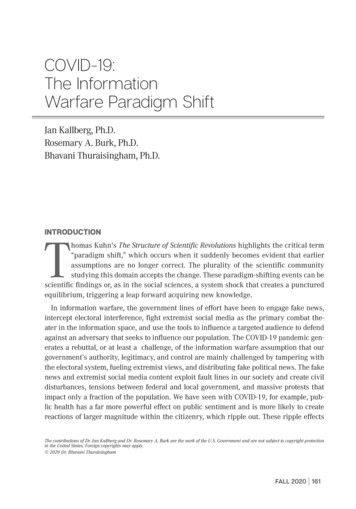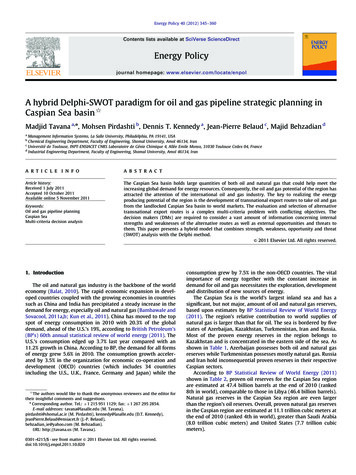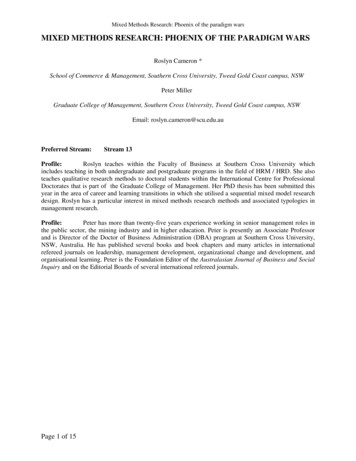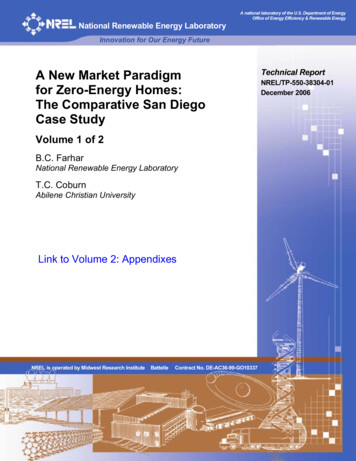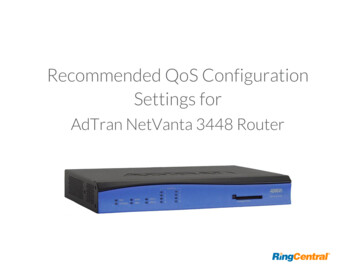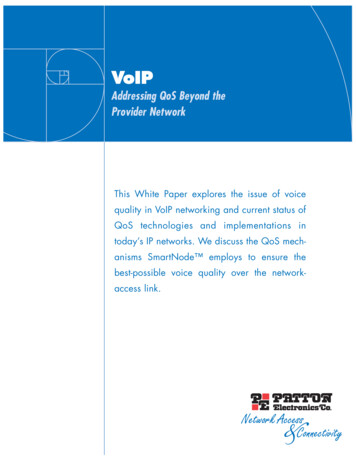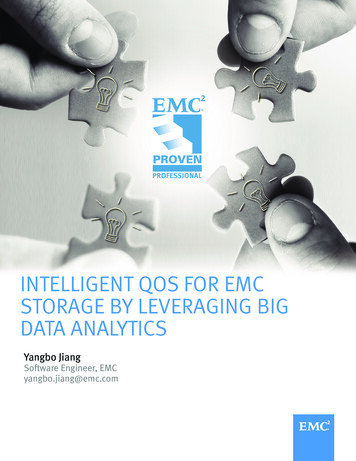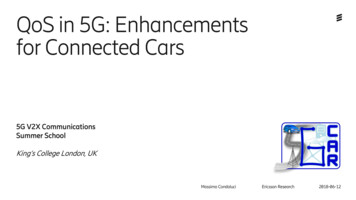
Transcription
The QoS Paradigm ShiftTim SzigetiBRKRST-2056szigeti@cisco.com@tim szigetihttp://tinyurl.com/j6cz9rz
October 1331 B.C.Gaugamela
Alexander of Macedon47,000October 1331 B.C.GaugamelaDarius III of Persia200,0001,000,000
strategy ˈstratəjē noun (pl. strategies)a plan of action or policy designed to achieve amajor or overall aim.tactic ˈtaktik nounan action carefully planned to immediately support ahigher-level objective, aiming at an end beyond theimmediate action.Often contrasted with strategy.
Alexander the Great’s Strategy and Tactics Overall Goal: Conquer Persia The World ck the KingLoyalty of his troopsConquered SubjectsGreek mercenaries, rebellion, insurrectionTactics @ IssusTactics @ GranicusTactics @ Gaugamela Attack the King Attack the King Attack the King Lead from the front &reward the troops Lead from the front &reward the troops Lead from the front &reward troops Fair treatment ofconquered subjects Fair treatment ofconquered subjects Greek mercenariesfighting for PersiaFair treatment ofconquered subjects,including VIP prisoners:Darius wife, mother andtwo daughters Greek Mercenariesfighting for Persia Refrain from action if notaligned to strategy Greek mercenaries
Session GoalsBy the end of this session, you should be able to Apply Cisco’s QoS paradigm shift to meet your business needs Deploy Cisco’s most popular campus feature Configure QoS for 1400 apps in a standards-based 12-class model—within 60 lines of (non-macro) CLI Appreciate a technology that can unambiguously identify thousands ofapplications on any network device and without any client software—even if these applications are encrypted! Understand the inner-workings of Cisco’s platform for SDN QoS in the enterprise
Agenda The QoS Paradigm Shift Strategic and Tactical QoS Design Case Study AutoQoS SRND4 NBAR2 QoS Attributes DNS-AS Prime Infrastructure AVC/QoS Profiles APIC-EM EasyQoS (SDN QoS) Looking Forward Summary and References
The QoS Paradigm Shift
The Why / How / What of Enterprise NetworkingCiscoEnterpriseVisionWhyTransform our customers’ businessesthrough powerful yet simple networks.HowWhat
What Do You Consider First?
Where to Begin?Always, Always, Always Start with Defining Your Business Goals of QoS Guaranteeing voice quality meets enterprise standards Ensuring a high Quality of Experience for video applications Improving user productivity by minimizing network response times Managing business applications that are “bandwidth hogs” Identifying and de-prioritizing non-business applications Improving network availability by protecting the control planes Hardening the network infrastructure to deal with abnormal events
Levels of QoS Policy AbstractionStrategic vs. Tactical Strategic QoS Policy (WHY) reflects business intent not constrained by any technical or administrative limitation end-to-end Tactical QoS Policy (HOW) expresses the strategic business intent with maximum fidelity limited by tactical constraints, including: Media (e.g. WLAN has only 4 levels of service)Platform (e.g. Catalyst 3750 has only 4 hardware queues)Interface (e.g. T1 WAN link has limited bandwidth)Role (e.g. CE may need to map into reduced sub-set of SP Classes-of-Service)
Defining theStrategic QoS Policy
Defining the Strategic QoS PolicyThree Step Process1)Decide the business-relevance of applications2)Assign the appropriate (RFC 4594) traffic-class for the application3)Specify target bandwidth allocations per traffic-class
Determining Business RelevanceHow Important is an Application to Your Business?Relevant These applications directlysupport business objectives Applications should beclassified, marked andtreated marked according toindustry best-practicerecommendationsRFC 4594DefaultIrrelevant These applications may/may notsupport business objectives(e.g. HTTP/HTTPS/SSL) These applications do notsupport business objectives andare typically consumer-oriented Applications of this type shouldbe treated with a DefaultForwarding service Applications of this type shouldbe treated with a “less-than BestEffort” serviceRFC 2474RFC 3662
What Do We Do Under-the-Hood?Apply RFC 4594-based Marking / Queuing / Dropping HopQueuing &ApplicationClassBehaviorDroppingExamplesVoIP TelephonyEFPriority Queue (PQ)Cisco IP Phones (G.711, G.729)Broadcast VideoCS5(Optional) PQCisco IP Video Surveillance / Cisco Enterprise TVReal-Time InteractiveCS4(Optional) PQCisco TelePresenceMultimedia ConferencingAF4BW Queue DSCP WREDCisco Jabber, Cisco WebExMultimedia StreamingAF3BW Queue DSCP WREDCisco Digital Media System (VoDs)Network ControlCS6BW QueueEIGRP, OSPF, BGP, HSRP, IKESignalingCS3BW QueueSCCP, SIP, H.323Ops / Admin / Mgmt (OAM)CS2BW QueueSNMP, SSH, SyslogTransactional DataAF2BW Queue DSCP WREDERP Apps, CRM Apps, Database AppsBulk DataAF1BW Queue DSCP WREDE-mail, FTP, Backup Apps, Content DistributionDefault ForwardingDFDefault Queue REDDefault ClassScavengerCS1Min BW Queue (Deferential)YouTube, Netflix, iTunes, BitTorrent, Xbox Live
What Do We Do Under-the-Hood?Apply RFC 4594-based Marking / Queuing / Dropping HopQueuing &ApplicationClassBehaviorDroppingExamplesVoIP TelephonyEFPriority Queue (PQ)Cisco IP Phones (G.711, G.729)Broadcast VideoCS5(Optional) PQCisco IP Video Surveillance / Cisco Enterprise TVReal-Time InteractiveCS4(Optional) PQCisco TelePresenceMultimedia ConferencingAF4BW Queue DSCP WREDCisco Jabber, Cisco WebExMultimedia StreamingAF3BW Queue DSCP WREDCisco Digital Media System (VoDs)Network ControlCS6BW QueueEIGRP, OSPF, BGP, HSRP, IKESignalingCS3BW QueueSCCP, SIP, H.323Ops / Admin / Mgmt (OAM)CS2BW QueueSNMP, SSH, SyslogTransactional DataAF2BW Queue DSCP WREDERP Apps, CRM Apps, Database AppsBulk DataAF1BW Queue DSCP WREDE-mail, FTP, Backup Apps, Content DistributionDefault ForwardingDFDefault Queue REDDefault ClassScavengerCS1Min BW Queue (Deferential)YouTube, Netflix, iTunes, BitTorrent, Xbox Live
Application Classification RulesIs the Protocol a Control Plane naling?No SignalingYesOAM?network routing and control-plane protocols E.g. BGP, OSPF, EIGRP, HSRP, IKE, etc.Signaling protocol? call signaling / bandwidth reservation protocols YesNetwork Control protocol? Network ControlE.g. SIP, Skinny, H.323, RSVP etc.Operations / Administration / Management protocol? network management protocols (e.g. SNMP, Telnet, SSH, Syslog, NetFlow, etc.)OAM
Application Classification Rules (cont.)Is the Application Voice?Voice?YesVoiceNo Voice? Audio-only media (e.g. G.711, G.729 etc.) Note: This class may be used for the audio-component of multimedia applications, such as CiscoJabber and/or Spark; however, this option should ONLY be considered if this causes no conflictwith your overall Call Admission Control strategy and voice-queue provisioning
Application Classification Rules (cont.)Is the Application esElastic?YesNoBroadcast Video(Inelastic)Elastic?YesNo(Inelastic) Video? Multimedia-StreamingIs the application is unidirectional or bidirectional?Is the application is elastic (i.e. adaptive to congestion/drops) or ive
Application Classification Rules (cont.)Is the Application Data?Data?NoYesForeground?No(Background or Unknown)YesTransactional DataBulk DataBest Effort Data? Is the application foreground or background? Foreground applications will directly impact user-productivity with network delaysBackground applications will not (as these are typically machine-to-machine flows) However, these apps can be very bandwidth intensive (if unrestrained) If it is not known if a data app is foreground, then assume it is backgroundOtherwise – the application/protocol remains in the default class (Best Effort)
Strategic Target Bandwidth Allotment ExampleVoice10%Best Effort25%Broadcast Video10%Scavenger1%Real-TimeInteractive13%Bulk Data4%Network Control2%Transactional encing10%Signaling2%
Strategic QoS 3cmrc16lugm6sdr8y
Defining TacticalQoS Policies
Defining the Tactical QoS PolicyObjectives and Method The principle goal of the tactical QoS policy is to express the strategic QoSpolicy to the maximum capacity possible, given the relevant tactical constraints QoS features should only be selectively enabled if they directly contribute toexpressing the strategic policy on a given platform e.g. if more than 4 classes of traffic are considered business relevant and a platform hasonly 4 hardware queues, then then these will be mapped as efficiently as possible into theplatform’s queuing modeli.e. QoS features will not be enabled simply for the sake of enabling featuresQoS design best practices will be used to generate platform-specificconfigurations to reflect the strategic QoS policy with maximum fidelity
A QoS Tools Review isincluded in the AppendixQoS Design Best PracticesClassification & Marking Best Practices Always enable QoS policies in hardware—rather than software—whenever a choice exists Classify and mark applications as close to their sources as technically and administrativelyfeasible Use DSCP marking whenever possible Follow standards-based DSCP PHB markings to ensure interoperability and futureexpansionVersion/Header LenToSByteLength IDOffsetTTLProtocolFCSIP SAIP DADataIPv4 Packet76543DiffServ Code Point (DSCP)210IP ECN
QoS Design Best PracticesPolicing and Remarking Best Practices Police traffic flows as close to their source as possible Whenever possible, markdown according to standards-based rules For Example: Assured Forwarding Traffic (AF21 example) Conforming AF21 traffic is marked/remarked AF21Exceeding AF21 traffic is remarked AF22Violating AF21 traffic is remarked AF23PIRCIRPBSB TpPacket ofSize BNoCBSB TcYesViolateYesExceedActionActionNoConformAction
QoS Design Best PracticesQueuing Best Practices Enable queuing policies at every node that has the potential for congestion Whenever possible, assign each application class to its own dedicated queue Use only platforms and/or service providers that offer a minimum of fourstandards-based queuing behaviors: An RFC 3246 Expedited Forwarding Per-Hop Behavior An RFC 2597 Assured Forwarding Per-Hop Behavior An RFC 2474 Default Forwarding Per-Hop Behavior An RFC 3662 Lower Effort Per-Domain Behavior
QoS Design Best PracticesWRED Principles Enable DSCP-based WRED on AF queues and DF queue Do not enable DSCP-based WRED on the EF queue Do not enable WRED on control traffic application class queues WRED is not required on the Scavenger queue Optional: Tune WRED thresholds consistently—for example: Set the minimum WRED thresholds for AFx3 to 60% of the queue depthSet the minimum WRED thresholds for AFx2 to 70% of the queue depthSet the minimum WRED thresholds for AFx1 to 80% of the queue depthSet all maximum WRED thresholds to 100%AF13 Minimum WRED Threshold:Begin randomly dropping AF13 PacketsAF12 Minimum WRED Threshold:Begin randomly dropping AF12 PacketsAF11 Minimum WRED Threshold:Begin randomly dropping AF11 Packets
QoS Design Best PracticesPer-Hop Behavior Principles EF Queue Recommendations: AF Queue Recommendations: Provision guaranteed bandwidth allocations according to application requirementsEnable DSCP-based WRED on this queue(s)DF Queue Recommendations: Limit the amount of strict priority queuing to 33% of link bandwidth capacityGovern strict-priority traffic with an admission control mechanismDo not enable WRED on this queueProvision at least 25 percent of link bandwidth for the default Best Effort classEnable WRED (effectively RED) on the default classScavenger Queue Recommendations: Assign minimum bandwidth to the Scavenger-class queueWRED is not required on the Scavenger-class queue
Trust BoundaryTrust BoundariesUntrusted / User-Administered Devicesno mls qos trustTrust BoundaryThe trust boundary is the edge where Layer 2 (CoS / UP) and/or Layer 3 (DSCP)markings are accepted or rejectedTrusted Centrally-Administered Devicesmls qos trust dscpTrust BoundaryCentrally-Administered &Conditionally-Trusted Devicesmls qos trust device cisco-phone cts ip-camera media-player
Policy Enforcement Points (PEPs) The Policy Enforcement Point (PEP) is the edge where classification and marking policies are enforcedThe PEP may or may not be the same as the trust boundaryMultiple PEPs may exist for different types of network devices e.g. switch PEP vs. router PEPTrust BoundarySwitchPEPRouterPEPNote: For the sake of simplification, in this deck PEP will refer toclassification and marking policy enforcement points (only)and will not include other policy enforcement points (e.g. queuing).
Tactical QoS Design 3cmrc16lugm6sdr8y
Agenda The QoS Paradigm Shift Strategic and Tactical QoS Design Case Study AutoQoS SRND4 NBAR2 QoS Attributes DNS-AS Prime Infrastructure AVC/QoS Profiles APIC-EM EasyQoS (SDN QoS) Looking Forward Summary and References
Strategic and Tactical QoS DesignCase StudyAll Case Study detailed chapters with full-configs are posted ugm6sdr8y
Case Study: Tifosi SoftwareOriginal Four-Class QoS and Queuing Models4-Class ModelDSCPVoiceEFSignalingCS3“Mission-Critical Data”AF31Best EffortDFBest aling7%
Case Study: Tifosi SoftwareCurrent Business Requirements The imminent deployment of two dozen Cisco TelePresence Systems one each in every major engineering and sales office with future plans for more to come The emerging popularity of multimedia collaboration applications Too many applications classified as “mission critical” including email, file-transfers, backup operations, etc.The identification of “substantial” amounts of non-business traffic on the networkduring work hours including Cisco WebEx, Cisco Jabber, as well as Microsoft Lyncincluding Netflix, YouTube, BitTorrent and iTunes downloads, as well as gaming trafficA desire for greater overall QoS policy-consistency
Case Study: Tifosi SoftwareProposed Eight-Class Strategic QoS Model8-Class Model4-ClassDSCPVoiceEFReal-Time InteractiveCS4SignalingCS3Multimedia onalDataAF21Bulk DataAF11ScavengerCS1Best EffortDFVoice10%Best Effort25%Scavenger1%Real-Time Interactive23%Bulk Data4%Transactional Data25%MultimediaConferencing10%Signaling2%
Case Study: Tifosi SoftwareCampus Access Catalyst 3750 Eight-Class (1P3Q3T) Egress Queuing ModelApplication ClassesDSCPVoiceEF1P3Q3TAF1CS1Realtime InteractiveCS4DFMultimedia ConferencingAF4SignalingCS3Transactional DataAF2Queue 4(5%)AF1ScavengerCS1DFQ4T11 Priority Queue3 (Non-Priority)Queues(each with)3 Drop ThresholdsQueue 3 (35%)CS3AF4EFBest EffortQ4T2Default QueueQueue 2Q2T2(30%)Q2T1AF2Bulk Data1P3Q3T CS4Q2T1 Queue 2,Threshold 1Q1Priority Queue
Case Study: Tifosi SoftwareCampus Distribution Catalyst 4500 Eight-Class (1P7Q1T DBL) Queuing ModelApplication ClassesDSCPVoiceEFRealtime InteractiveCS4Multimedia ConferencingAF4SignalingCS31P7Q1T DBLEFPriorityQueueCS4AF4CS3Multimedia ConferencingQueue(10% BWR DBL)DBL Signaling Queue(2% BWR)DynamicLimitingTransactional DataAF2AF2Transactional DataQueue(25% BWR DBL)Bulk DataAF1AF1Bulk Data Queue(4% BWR DBL)ScavengerCS1CS1Scavenger (1% BWR)Best EffortDFDFDefault Queue(25% BWR DBL)BufferBWR BandwidthRemaining
Case Study: Tifosi SoftwareCampus Core Catalyst 6500 Eight-Class (8Q4T & 1P7Q4T) Queuing ModelsApplication ClassesDSCPVoiceEF8Q4T / 1P7Q4T WREDEFRealtime InteractiveCS4CS4SignalingCS3CS3Multimedia ConferencingAF4Transactional DataAF2Realtime-Queue(33% BW/Priority)Signaling Queue(2% BW/BWR)AF4Multimedia Conferencing Queue(10% BW /BWR DSCP-based WRED)AF2Transactional Data Queue(25% BW/BWR DSCP-based WRED)Bulk DataAF1AF1ScavengerCS1CS1Best EffortDFDFBulk Data Queue(4% BW/BWR DSCP-based WRED)Scavenger Queue(1% BW/BWR)Default Queue(25% BW/BWR WRED)
Case Study: Tifosi SoftwareCentralized Cisco 5508 Wireless LAN Controller (8.1MR) 802.11e WMM ModelApplication ClassesDSCPVoiceEF UP 6Realtime InteractiveCS4 UP 5SignalingCS3 UP 4Multimedia ConferencingAF4Transactional DataAF2 UP 3802.11e User Priorities (UP)& WLC Access CategoriesUP 7UP 6UP 5UP 4AF1 UP 2ScavengerCS1Best EffortDFGoldUP 3UP 0Bulk DataPlatinumUP 2UP 1SilverBronze
Case Study: Tifosi SoftwareDC Fabric Cisco Nexus 7000 F2 (nq-7e: 4Q1T / 1P3Q1T) Queuing ModelApplication ClassDSCPCoSNetwork ControlN/ACoS 7Internetwork ControlCS6CoS 6Voice /Realtime InteractiveEF /CS4CoS 5Video /SignalingAF4 /CS3*CoS 4FCoEN/ACoS 3Transactional DataAF2CoS 2Bulk Data /vMotionAF1 /N/ACoS 1*Best EffortDFCoS 04Q1T / 1P3Q1TCoS 7CoS 6CoS 5In-Q1 / Out-PQ14Q1T: 25% BW 7% QL1P3Q1T: Priority Level 1In-Q3 / Out-Q34Q1T: 25% BW 31% QL1P3Q1T: 20% BWRCoS 2CoS 4CoS 3In-Q4 / Out-Q2No Drop4Q1T: 25% BW 30% QL1P3Q1T: 40% BWRQ-Default(In-Q2 / Out-Q4)4Q1T: 25% BW 32% QLCoS 01P3Q1T: 40% BWRCoS 1
Case Study: Tifosi SoftwareMPLS VPN Customer-Edge Enterprise-to-Service Provider MappingCustomer 8-Class ModelDSCPVoiceEFRealtime InteractiveCS4SignalingCS3 CS4Multimedia ConferencingAF41 AF31Transactional DataAF21Bulk DataAF11ScavengerCS1Best EffortDFSP Six-Class ModelClasses-of-ServiceEFCS5SP-REALTIME-CLASS (RTP)LLQ 10%AF41CS4SP-AF4-CLASS (RTP)CBWFQ 25% BW DSCP-WREDAF31CS3SP-AF3-CLASS (UDP)CBWFQ 10% BW DSCP-WREDAF21CS2SP-AF2-CLASS (TCP)CBWFQ 25% BW DSCP-WREDAF11CS1SP-AF1-CLASS (Control)CBWFQ 5% BW DSCP-WREDDFSP-DEFAULT-CLASSCBWFQ 25% BW WRED
Agenda The QoS Paradigm Shift Strategic and Tactical QoS Design Case Study AutoQoS SRND4 NBAR2 QoS Attributes DNS-AS Prime Infrastructure AVC/QoS Profiles APIC-EM EasyQoS (SDN QoS) Looking Forward Summary and References
AutoQoS SRND4
Cisco Customers
AutoQoS SRND4 Overview AutoQoS features are based on QoS Design Guides Cisco has provided AutoQoS for VoIP since 2002 Cisco has expanded AutoQoS to include: Cisco TelePresenceCisco IP Video SurveillanceMultimedia conferencing applicationsMultimedia streaming applicationsTransactional data applicationsBulk data applicationsScavenger applications328 pages1043pages208pages154pagesCH1-CH3:320 pages An administrator can automatically provision platform-specific best-practice designs via asingle interface-level command AutoQoS is the most deployed feature on Cisco Catalyst switches (26%)
AutoQoS SRND4auto qos video [ cts ip-camera ]auto qos classifyMM-Conferencing ClassifierSignaling ClassifierTransactional Data ClassifierBulk Data ClassifierScavenger ClassifierBest Effort (Class-Default)auto qos classify { police }Mark AF41Mark CS3Mark AF21Mark AF11Mark CS1Mark DFMM-Conf Policer ( 5 Mbps)YesNoSignaling Policer ( 32 kbps)YesNoTrans-Data Policer ( 10 Mbps)YesNoBulk Data Policer ( 10 Mbps)YesNoScavenger Policer ( 10 Mbps)YesNoBest Effort Policer ( 10 Mbps)YesNoDropDropRemark to CS1Remark to CS1DropRemark to CS11P3Q3T Egress Queuing Policiesauto qos trust { cos dscp }1P1Q3T Ingress Queuing Policiesauto qos voip [ cisco-phone cisco-softphone trust ]
AutoQoS SRND4—VoIP Modelsauto qos voip trustauto qos voip cisco-phoneBest Effort (Class-Default)Mark CS3Mark DFVoIP Policer ( 128 kbps)YesNoSignaling Policer ( 32 kbps)YesNoBest Effort Policer ( 10 Mbps)YesNoRemark to CS1Remark to CS1Remark to CS1auto qos voip cisco-softphoneVoIP ClassifierSignaling ClassifierMultimedia ConferencingClassifierSignaling ClassifierTransactional Data ClassifierBulk Data ClassifierScavenger ClassifierBest Effort (Class-Default)Mark EFMark CS3Mark AF41Mark CS3Mark AF21Mark AF11Mark CS1Mark DFVoIP Policer (
Session Goals Apply Cisco’s QoS paradigm shift to meet your business needs Deploy Cisco’s most popular campus feature Configure QoS for 1400 apps in a standards-based 12-class model— within 60 lines of (non-macro) CLI Appreciate a technology that can unambiguously identify thousands of applicatio
